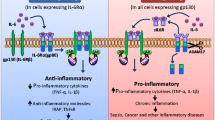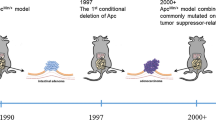Abstract
Significant advances have been made recently in our understanding of how several cell signaling pathways contribute to the early stages of colorectal carcinogenesis, particularly in the context of colitis-associated colorectal cancer (CRC). For example, we now know that nuclear factor κB, a transcription factor, plays a critical role in a mouse model of colitis-associated CRC and that the oncogene c-MYC is essential for the phenotypic consequences of adenomatous polyposis coli tumor suppressor gene loss in mouse intestine. A major challenge now is to determine the relevance of findings in colitis-associated CRC models to the more common “sporadic” form of colorectal carcinogenesis. It is becoming increasingly clear that there is cross-talk between important cell signaling pathways (eg, Wnt) and prostaglandin signaling. These preclinical findings should inform the design of translational studies prior to clinical testing, to determine the most efficient combination of chemopreventive agents.
Similar content being viewed by others
References and Recommended Reading
Vogelstein B, Kinzler KW: Cancer genes and the pathways they control. Nat Med 2004, 10:789–799.
Arnold CN, Goel A, Blum HE, Boland CR: Molecular pathogenesis of colorectal cancer: implications for molecular diagnosis. Cancer 2005, 104:2035–2047.
Kitisin K, Mishra L: Molecular biology of colorectal cancer: New targets. Semin Oncol 2006, 33(suppl 11):S14–S23.
van den Brink GR, Offerhaus GJ: The morphogenetic code and colon cancer development. Cancer Cell 2007, 11:109–117.
Jass JR: Classification of colorectal cancer based on correlation of clinical, morphological and molecular features. Histopathology 2007, 50:113–130.
Barker N, Clevers H: Mining the Wnt pathway for cancer therapeutics. Nat Rev Drug Discov 2006, 5:997–1014.
Sansom OJ, Meniel VS, Muncan V, et al.: Myc deletion rescues Apc deficiency in the small intestine. Nature 2007, 446:676–679.
Dang CV, O’Donnell KA, Zeller KI, et al.: The c-Myc target gene network. Semin Cancer Biol 2006, 16:253–264.
Bommer GT, Fearon ER: Role of c-Myc in Apc mutant intestinal phenotype: Case closed or time for a new beginning? Cancer Cell 2007, 11:391–394.
Castellone MD, Teramoto H, Williams BO, et al.: Prostaglandin E 2 promotes colon cancer cell growth through a novel G s -axin-β-catenin signaling axis. Science 2005, 310:1504–1510.
Wang D, Wang H, Shi Q, et al.: Prostaglandin E 2 promotes colorectal adenoma growth via transactivation of the nuclear peroxisome proliferator-activated receptor δ. Cancer Cell 2004, 6:285–295.
Pai R, Soreghan B, Szabo IL, et al.: Prostaglandin E 2 transactivates EGF receptor: a novel mechanism for promoting colon cancer growth and gastrointestinal hypertrophy. Nat Med 2002, 8:289–293.
Torrance CJ, Jackson PE, Montgomery E, et al.: Combinatorial chemoprevention of intestinal neoplasia. Nat Med 2000, 6:1024–1028.
Hull MA: Cyclooxygenase-2: How good is it as a target for cancer chemoprevention? Eur J Cancer 2005, 41:1854–1863.
Baron J, Sandler RS, Bresalier RS, et al.: A randomized trial of rofecoxib for the chemoprevention of colorectal adenomas. Gastroenterology 2006, 131:1674–1682.
Bertagnolli MM, Eagle CJ, Zauber AG, et al.: Celecoxib for the prevention of sporadic colorectal adenomas. N Engl J Med 2006, 355:873–884.
Arber N, Eagle CJ, Spicak J, et al.: Celecoxib for the prevention of colorectal adenomatous polyps. N Engl J Med 2006, 355:885–895.
Grosser T, Fries S, Fitzgerald GA: Biological basis for the cardiovascular consequences of COX-2 inhibition: therapeutic challenges and opportunities. J Clin Invest 2006, 116:4–15.
Wu KK: Transcription-based COX-2 inhibition: a therapeutic strategy. Thromb Haemost 2006, 96:417–422.
Hull MA, Faluwi OO, Ko CWS, et al.: Regulation of stromal cell cyclooxygenase-2 expression in the Apc Min/+ mouse model of intestinal tumorigenesis. Carcinogenesis 2006, 27:382–391.
Murakami M, Kudo I: Prostaglandin E synthase: a novel drug target for inflammation and cancer. Curr Pharm Des 2006, 12:943–954.
Hull MA, Ko SCW, Hawcroft G: Prostaglandin EP receptors: targets for treatment and prevention of colorectal cancer? Mol Cancer Therap 2004, 3:1031–1039.
Tai H-H, Cho H, Tong M, et al.: NAD+-linked 15-hydroxyprostaglandin dehydrogenase: structure and biological functions. Curr Pharm Des 2006, 12:955–962.
Yan M, Rerko RM, Platzer P, et al.: 15-hydroxyprostaglandin dehydrogenase, a COX-2 oncogene antagonist, is a TGF-β-induced suppressor of human gastrointestinal cancers. Proc Natl Acad Sci USA 2004, 101:17468–17473.
Shoji Y, Takahashi M, Kitamura T, et al.: Downregulation of prostaglandin E receptor subtype EP 3 during colon cancer development. Gut 2004, 53:1151–1158.
Cha YI, DuBois RN: NSAIDs and cancer prevention: targets downstream of COX-2. Annu Rev Med 2007, 58:239–252.
Itzkowitz SH: Molecular biology of dysplasia and cancer in inflammatory bowel disease. Gastroenterol Clin North Am 2006, 35:553–571.
Greten FR, Eckmann L, Greten TF, et al.: IKKβ links inflammation and tumorigenesis in a mouse model of colitis-associated cancer. Cell 2004, 118:285–296.
Karin M, Yamamoto Y, Wang QM: The IKK NF-kappa B system: a treasure trove for drug development. Nat Rev Drug Discov 2004, 3:17–26.
Albini A, Sporn MB: The tumour microenvironment as a target for chemoprevention. Nat Rev Cancer 2007, 7:139–147.
Lee MS, Kim Y-J: Signaling pathways downstream of pattern-recognition receptors and their cross talk. Annu Rev Biochem 2007, 76:447–480.
Xiao H, Gulen MF, Qin J, et al.: The Toll-interleukin-1 receptor member SIGIRR regulates colonic epithelial homeostasis, inflammation, and tumorigenesis. Immunity 2007, 26:461–475.
de Jong YP, Abadia-Molina AC, Satoskar AR, et al.: Development of chronic colitis is dependent on the cytokine MIF. Nat Immunol 2001, 2:1061–1066.
Wilson JM, Coletta PL, Cuthbert RJ, et al.: Macrophage migration inhibitory factor promotes intestinal tumorigenesis. Gastroenterology 2005, 129:1485–1503.
Chapple KS, Cartwright EJ, Hawcroft G, et al.: Localization of cyclooxygenase-2 in human sporadic colorectal adenomas. Am J Pathol 2000, 156:545–553.
Swidsinski A, Khilkin M, Kerjaschki D, et al.: Association between intraepithelial Escherichia coli and colorectal cancer. Gastroenterology 1998, 115:281–286.
Duerr RH, Taylor KD, Brant SR, et al.: A genome-wide association study identifies IL23R as an inflammatory bowel disease gene. Science 2006, 314:1461–1463.
Sheibanie AF, Yen J-H, Khayrullina T, et al.: The proinflammatory effect of prostaglandin E 2 in experimental inflammatory bowel disease is mediated through the IL-23→IL-17 axis. J Immunol 2007, 178:8138–8147.
Hao J-S, Shan BE: Immune enhancement and anti-tumour activity of IL-23. Cancer Immunol Immunother 2006, 55:1426–1431.
Rao CV: Nitric oxide signalling in colon cancer chemoprevention. Mutation Res 2004, 555:107–119.
Cassero RA, Marton LJ: Targeting polyamine metabolism and function in cancer and other hyperproliferative diseases. Nat Rev Drug Discov 2007, 6:373–390.
Gerner EW: Impact of dietary amino acids and polyamines on intestinal carcinogenesis and chemoprevention in mouse models. Biochem Soc Trans 2007, 35:322–325.
Scott DJ, Hull MA, Cartwright EJ, et al.: Lack of inducible nitric oxide synthase promotes intestinal tumorigenesis in the Apc Min/+ mouse. Gastroenterology 2001, 121:889–899.
Tucker JM, Murphy JT, Kisiel N, et al.: Potent modulation of intestinal tumorigenesis in Apc min/+ mice by the polyamine catabolic enzyme spermidine/spermine N 1 -acetyltransferase. Cancer Res 2005, 65:5390–5398.
Kohno H, Takahashi M, Yasui Y, et al.: A specific inducible nitric oxide synthase inhibitor, ONO-1714, attenuates inflammation-related large bowel carcinogenesis in male Apc Min/+ mice. Int J Cancer 2007, 121:506–513.
Gunter MJ, Leitzmann MF: Obesity and colorectal cancer: epidemiology, mechanisms and candidate genes. J Nutr Biochem 2006, 17:145–156.
Chen H: Cellular inflammatory responses: novel insights for obesity and insulin resistance. Pharmacol Res 2006, 53:469–477.
Scheller J, Ohnesorge N, Rose-John S: Interleukin-6 trans-signalling in chronic inflammation and cancer. Scand J Immunol 2006, 63:321–329.
Chan AT, Ogino S, Fuchs CS: Aspirin and the risk of colorectal cancer in relation to the expression of COX-2. N Engl J Med 2007, 356:2131–2142.
Nguyen H, Tran A, Lipkin S, Fruehauf JP: Pharmacogenomics of colorectal cancer prevention and treatment. Cancer Invest 2006, 24:630–639.
Author information
Authors and Affiliations
Corresponding author
Rights and permissions
About this article
Cite this article
Hull, M.A. Molecular pathways leading to cancer as a basis for preventive strategies. Curr colorectal cancer rep 4, 43–47 (2008). https://doi.org/10.1007/s11888-008-0008-z
Published:
Issue Date:
DOI: https://doi.org/10.1007/s11888-008-0008-z




